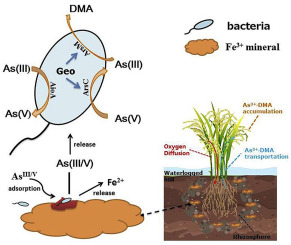Environmental Pollution ( IF 7.6 ) Pub Date : 2020-01-20 , DOI: 10.1016/j.envpol.2020.114010 Shengguo Xue 1 , Xingxing Jiang 1 , Chuan Wu 1 , William Hartley 2 , Ziyan Qian 1 , Xinghua Luo 1 , Waichin Li 3

|
The microbe-driven iron cycle plays an important role in speciation transformation and migration of arsenic (As) in soil-rice systems. In this study, pot experiments were used to investigate the effect of bacterial iron (Fe) reduction processes in soils on As speciation and migration, as well as on As uptake in soil-rice system. During the rice growth period, pH and electrical conductivity (EC) in soil solutions initially increased and then later decreased, with the ranges of 7.4–8.8 and 116.3–820 mS cm−1, respectively. The concentrations of Fe, total As and As(III) showed an increasing trend in the rhizosphere and non-rhizosphere soil solutions with the increasing time. Fe concentrations were significantly positively correlated with total As and As(III) concentrations (***p < 0.001) in the soil solutions. The abundances of the arsenate reductase gene (arsC) and the As(III) S-adenosylmethionine methyltransferase gene (arsM) in rhizosphere soils were higher than those in non-rhizosphere soils, while the abundance of the Fe-reducing bacteria (Geo) showed the opposite trend. Moreover, it showed that the Geo abundance was significantly positively correlated with that of the arsC (***p < 0.001) and arsM (**p < 0.01) genes, respectively. The abundance of Geo, arsC and arsM genes were significantly positively correlated with the concentrations of Fe, total As and As(III) in the soil solutions (*p < 0.05). Moreover, the abundances of arsC and arsM genes were significantly negatively correlated with total As and As(III) in rice grains (*P < 0.05). These results showed that the interaction of bacterial Fe reduction process and ROL from roots promoted the reduction and methylation of As, and then decreased As uptake by rice, which provided a theoretical basis for alleviating arsenic pollution in rice paddy soils.
中文翻译:

微生物驱动的铁还原影响土壤-水稻系统中砷的转化和运输。
微生物驱动的铁循环在土壤-水稻系统中的形态转变和砷(As)的迁移中起着重要作用。在这项研究中,盆栽实验用于研究土壤中细菌铁(Fe)还原过程对As形态和迁移以及土壤-水稻系统中As吸收的影响。在水稻生育期,土壤溶液的pH和电导率(EC)最初升高,然后降低,范围为7.4–8.8和116.3–820 mS cm -1, 分别。在根际和非根际土壤溶液中,Fe,总As和As(III)的浓度随时间的增加而增加。铁浓度与土壤溶液中总砷和砷(III)浓度呈显着正相关(*** p <0.001)。根际土壤中砷还原酶基因(arsC)和As(III)S-腺苷甲硫氨酸甲基转移酶基因(arsM)的丰度高于非根际土壤,而铁还原菌(Geo)的丰度显示相反的趋势。此外,它表明,地理丰度与arsC呈显着正相关(*** p <0.001),并且arsM(** p <0.01)基因。Geo,arsC和arsM基因的丰度与土壤溶液中Fe,总As和As(III)的浓度呈显着正相关(* p <0.05)。此外,水稻籽粒中arsC和arsM基因的丰度与总As和As(III)显着负相关(* P <0.05)。这些结果表明,细菌的铁还原过程与根部的ROL的相互作用促进了砷的还原和甲基化,进而降低了水稻对砷的吸收,为减轻水稻土中的砷污染提供了理论基础。











































 京公网安备 11010802027423号
京公网安备 11010802027423号